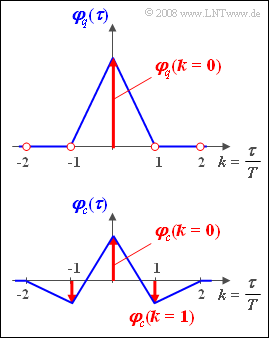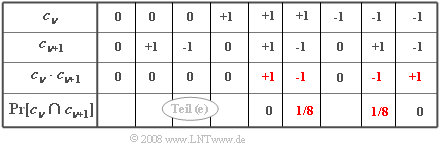Exercise 4.13Z: AMI Code
For spectral adaptation (shaping) of a digital signal to the characteristics of the channel, one uses so-called "pseudo-ternary codes". With these codes, the binary source symbol sequence ⟨qν⟩ is converted to a sequence ⟨cν⟩ of ternary symbols according to a fixed rule:
- qν∈{−1,+1}⇒cν∈{−1,0,+1}.
The best known representative of this code class is the AMI code (from "Alternate Mark Inversion"). Here
- the binary value qν=−1 is always mapped to cν=0 ,
- while qν=+1 is alternately represented by the ternary values cν=+1 and cν=−1.
By convention, the ternary symbol cν=+1 shall be selected at the first occurrence of qν=+1 .
It is further assumed that
- the two possible source symbols are each equally probable and
- the source symbol sequence ⟨qν⟩ has no internal statistical bindings.
Thus, all discrete ACF values are zero except φq(k=0):
- φq(k⋅T)=0ifk≠0.
Here T denotes the time distance between the source symbols. Use T=1µs. The code symbols have the same spacing.
The graphic shows the given auto-correlation functions. Please note:
- In red are respectively the discrete-time representations A{φq(τ)} and A{φc(τ)} of the auto-correlation functions, each with the reference value T.
- The functions shown in blue indicate the continuous-time progressions φq(τ) and φc(τ) of the ACF, assuming square-wave pulses.
Hints:
- This exercise belongs to the chapter Power-Spectral Density.
- Reference is also made to the chapter Auto-Correlation Function as well as to the page Numerical PSD determination.
- Use the following Fourier correspondence, where Δ(t) denotes a triangular pulse symmetric about t=0 with Δ(t=0)=1 and Δ(t)=0 for |t|≥T:
- Δ(t)∘−−−∙T⋅si2(πfT).
Questions
Solution
- Since qν can only take the values −1 and +1 ⇒ φq(k=0)=1_.
(2) Correct are the proposed solutions 1 and 3:
- The discrete-time ACF and its Fourier transform are:
- A{φq(τ)}=φq(k=0)⋅T⋅δ(τ)∘−−−∙P{Φq(f)}=φq(k=0)⋅T=T.
- It is considered that φq(k=0)=σ2q=1. This means: The periodic continuation of P{Φq(f)} thus gives the same value for all frequencies.
- In contrast, the continuous-time ACF can be represented as follows:
- φq(τ)=A{φq(τ)}⋆(δ(τ)/T).
- The associated power-spectral density (Fourier transform of the ACF) is then the product of the Fourier transforms of the two convolution terms:
- Φq(f)=P{Φq(f)}⋅sinc2(fT)=T⋅sinc2(fT).
- Based on the chosen ACF interpolation (with straight line intercepts) from their samples, a sinc2-shaped PSD is obtained.
- A rectangular spectrum according to the second proposed solution would only occur with sinc-shaped interpolation.
(3) The coded sequence is: ⟨+1, 0,−1,+1, 0,−1,+1, 0, 0, 0⟩. Thus the 6th code symbol is c6=−1_.
(4) The occurrence probabilities of the values −1, 0 and +1 are 0.25,0.5,0.25. It follows:
- φc(k=0)=0.25⋅(−1)2+0.5⋅02+0.25⋅(+1)2=0.5_.
(5) For the ACF value at k=1 consider the product cν⋅cν+1. The combinations shown in the table are obtained.
- Only products cν⋅cν+1≠0 with Pr[cν⋅cν+1]≠0:
- φc(k=1)=Pr[(cν=+1)∩(cν+1=−1)]⋅(+1)⋅(−1)+Pr[(cν=−1)∩(cν+1=+1)]⋅(−1)⋅(+1).
- In the table, these terms are marked in red. Further:
- Pr[(cν=+1)∩(cν+1=−1)]=
- =Pr(cν=+1)⋅Pr(cν+1=−1|cν=+1))=14⋅12=18.
- It is assumed that +1 occurs with probability 0.25 and is followed by −1 only in half of the cases.
- The same result is obtained for the second contribution. Thus applies:
- φc(k=1)=18⋅(+1)⋅(−1)+18⋅(−1)⋅(+1)=−0.25_.
- φc(k=−1)=φc(k=1)=−0.25_.
- To calculate φc(k=2) it is necessary to average over 33=27 combinations. The result is zero.
(6) The Fourier transform of the discrete-time ACF A{φc(τ)} is:
- P{Φc(f)}=T⋅φc(k=0)+2T⋅φc(k=1)⋅cos(2πfT).
- With the result of the last subtask, it follows:
- P{Φc(f)}=T2(1−cos(2πfT))=T⋅sin2(πfT).
- As shown in item (2): For the PSD – that is, the Fourier transform of φc(τ):
- Φc(f)=T⋅sin2(πfT)⋅sinc2(fT)=T⋅sin4(πfT)(πfT)2.
- ⇒Φc(f=0)=0_,Φc(f=500kHz)=T⋅sin4(π/2)(π/2)2=4Tπ2=0.405⋅10−6 1/Hz_.

